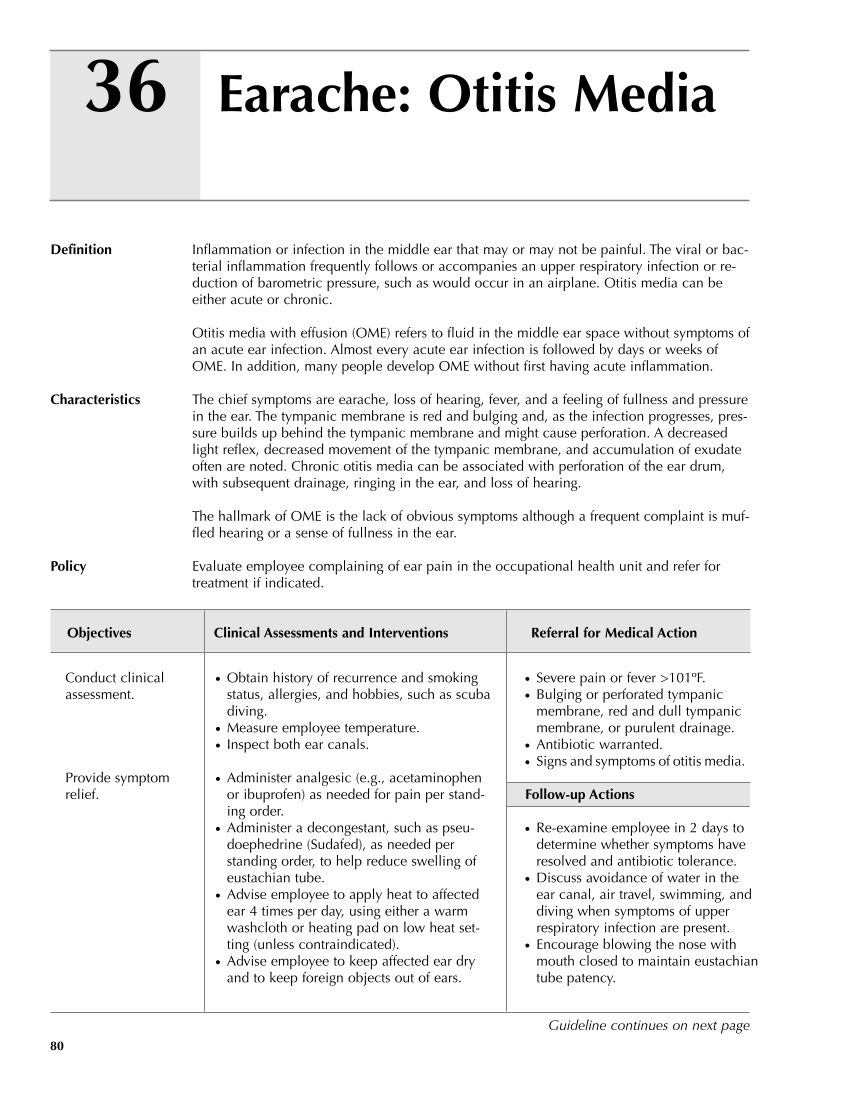36 80 Definition Inflammation or infection in the middle ear that may or may not be painful. The viral or bac- terial inflammation frequently follows or accompanies an upper respiratory infection or re- duction of barometric pressure, such as would occur in an airplane. Otitis media can be either acute or chronic. Otitis media with effusion (OME) refers to fluid in the middle ear space without symptoms of an acute ear infection. Almost every acute ear infection is followed by days or weeks of OME. In addition, many people develop OME without first having acute inflammation. Characteristics The chief symptoms are earache, loss of hearing, fever, and a feeling of fullness and pressure in the ear. The tympanic membrane is red and bulging and, as the infection progresses, pres- sure builds up behind the tympanic membrane and might cause perforation. A decreased light reflex, decreased movement of the tympanic membrane, and accumulation of exudate often are noted. Chronic otitis media can be associated with perforation of the ear drum, with subsequent drainage, ringing in the ear, and loss of hearing. The hallmark of OME is the lack of obvious symptoms although a frequent complaint is muf- fled hearing or a sense of fullness in the ear. Policy Evaluate employee complaining of ear pain in the occupational health unit and refer for treatment if indicated. Objectives Clinical Assessments and Interventions Referral for Medical Action Earache: Otitis Media ● Severe pain or fever 101ºF. ● Bulging or perforated tympanic membrane, red and dull tympanic membrane, or purulent drainage. ● Antibiotic warranted. ● Signs and symptoms of otitis media. Follow-up Actions ● Re-examine employee in 2 days to determine whether symptoms have resolved and antibiotic tolerance. ● Discuss avoidance of water in the ear canal, air travel, swimming, and diving when symptoms of upper respiratory infection are present. ● Encourage blowing the nose with mouth closed to maintain eustachian tube patency. Conduct clinical assessment. Provide symptom relief. ● Obtain history of recurrence and smoking status, allergies, and hobbies, such as scuba diving. ● Measure employee temperature. ● Inspect both ear canals. ● Administer analgesic (e.g., acetaminophen or ibuprofen) as needed for pain per stand- ing order. ● Administer a decongestant, such as pseu- doephedrine (Sudafed), as needed per standing order, to help reduce swelling of eustachian tube. ● Advise employee to apply heat to affected ear 4 times per day, using either a warm washcloth or heating pad on low heat set- ting (unless contraindicated). ● Advise employee to keep affected ear dry and to keep foreign objects out of ears. Guideline continues on next page
Purchased from OEM Press by (ge corporate access). (C) 2013 OEM Health Information, Inc. All rights reserved.












































































































































































































































































































































































































































